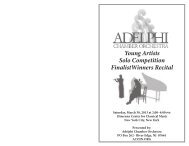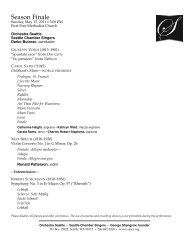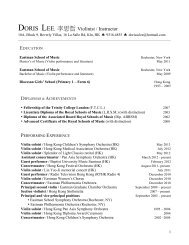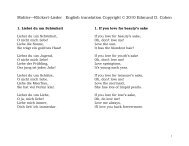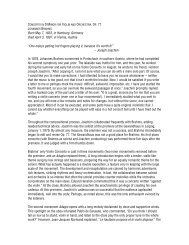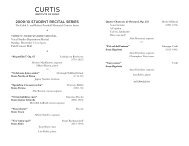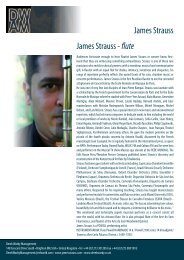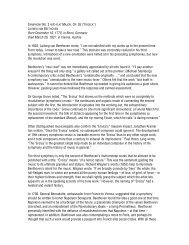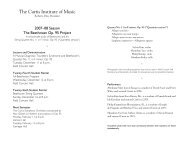Variations Human instinct is to imitate and imitation ... - InstantEncore
Variations Human instinct is to imitate and imitation ... - InstantEncore
Variations Human instinct is to imitate and imitation ... - InstantEncore
Create successful ePaper yourself
Turn your PDF publications into a flip-book with our unique Google optimized e-Paper software.
<strong>Variations</strong><br />
<strong>Human</strong> <strong>instinct</strong> <strong>is</strong> <strong>to</strong> <strong>imitate</strong> <strong>and</strong> <strong>imitation</strong> <strong>is</strong> strongly reinforced in musicians who repeat endlessly in practice <strong>to</strong><br />
perfect their craft. After repetition comes boredom; however, so change something! Variation <strong>is</strong> primal <strong>and</strong><br />
inevitable. The earliest variation form was div<strong>is</strong>ions—playing a melody, then inserting extra notes <strong>to</strong> make it<br />
twice, three times, four times as fast, etc., changing reg<strong>is</strong>ters for interest. By the time of Mozart, variation <strong>and</strong><br />
improv<strong>is</strong>ation were strongly intertwined. Take a simple theme, often by a rival, <strong>and</strong> show off what could really be<br />
done with it. By the Romantic era, novel exploitation of musical material exceeded improv<strong>is</strong>ers' abilities <strong>and</strong><br />
composers put their creations on paper. Tonight's program illustrates how far fancy can fly out of the minds of the<br />
greatest composers.<br />
Pyotr Ilyich Tchaikovsky (b. May 7, 1840, Votkinsk, Russia; d. November 6, 1893 in St. Petersburg)<br />
Mozartiana, Op. 61<br />
Sordid details of Tchaikovsky's life often seem <strong>to</strong> have some bearing on h<strong>is</strong> music. H<strong>is</strong> 4th Suite, dubbed<br />
Mozartiana, <strong>is</strong> an exception. Payments from h<strong>is</strong> patron Nadezhda von Meck arrived regularly in 1887 so he could<br />
give full attention <strong>to</strong> composing. He turned <strong>to</strong> Mozart because of the centennial of Mozart's Don Giovanni. There<br />
<strong>is</strong> no hint of anything other than a proper obe<strong>is</strong>ance <strong>to</strong> a past master, albeit one informed by late Romantic<br />
sensibilities.<br />
“Gigue” <strong>is</strong> a faithful transcription of Mozart's buoyant late keyboard work, Gigue K 574. With th<strong>is</strong> movement<br />
<strong>and</strong> the next, by borrowing from old dance-suite forms, Tchaikovsky gives himself cover for calling h<strong>is</strong><br />
collection of pieces a suite. “Menuet” comes from Minuet K 355/576b, a work that scholarship suggests <strong>is</strong> at<br />
least partly by Abbe Stadler. Both movements have rich chromatic harmonies that Tchaikovsky must have found<br />
appealing.<br />
The “Preghiera” (literally prayer) <strong>is</strong> not purely Mozart's Ave Verum Corpus, but rather L<strong>is</strong>zt's transcription that<br />
extends it with an introduction <strong>and</strong> coda. Mozart's ethereal reverence seems overlaid with opulent earthly delight,<br />
befitting the late 19th century.<br />
The bulk of the suite orchestrates Mozart's ten variations, K 455, on the aria “Les hommes pieusement” (Pious<br />
Men) from Gluck's comic opera The Unexpected Encounter. The ninth variation gives a dramatic role <strong>to</strong> the solo<br />
violin <strong>and</strong> the tenth features two clarinet cadenzas.<br />
Sergei Rachmaninoff (b. April 1, 1873 Semyonovo, Russia; d. March 28, 1943 in Beverly Hills)<br />
Rhapsody on a Theme of Paganini, Op. 43<br />
Many Rachmaninoff compositions are common concert fare <strong>to</strong>day, but most of them were written in tsar<strong>is</strong>t<br />
Russia when he was still a relatively young man. After he fled the Bolsheviks in 1918, he settled in the United<br />
States <strong>and</strong> remained exceedingly busy as a concert art<strong>is</strong>t until the end of h<strong>is</strong> life. Of the few works he wrote after<br />
going in<strong>to</strong> exile, Rhapsody on a Theme of Paganini st<strong>and</strong>s apart.<br />
The theme <strong>is</strong> from Paganini's Caprice in A minor, a solo violin spectacular written around 1809. So many<br />
composers since have used its material for their own works since that its appeal must be reckoned a force of<br />
nature. Yet Rachmaninoff in h<strong>is</strong> creation upstaged Paganini <strong>and</strong> all the rest. Its 1934 premiere was an unqualified<br />
success <strong>and</strong> it has remained hugely popular ever since.<br />
Rachmaninoff begins not with the theme but a punchy introduction <strong>and</strong> then the first variation. Th<strong>is</strong> <strong>is</strong> much like<br />
what CSO l<strong>is</strong>teners heard last fall where the finale of Beethoven's Eroica symphony doesn't present its theme<br />
until well in<strong>to</strong> the movement.<br />
The overarching form of the piece <strong>is</strong> very like many concer<strong>to</strong>s. A question <strong>to</strong> ponder: Why didn't Rachmaninoff<br />
call it a concer<strong>to</strong>? The beginning through variation 10 <strong>is</strong> like a typical concer<strong>to</strong>'s opening movement, relatively
quick tempos, etc. In Variation 7 the piano plays Dies Irae, the hymn for the dead while the orchestra plays a<br />
modification of the Paganini theme underneath. Did Rachmaninoff call h<strong>is</strong> work a rhapsody because he borrowed<br />
other material?<br />
<strong>Variations</strong> 11-18 as a group are like a concer<strong>to</strong>'s slow movement. Some of the piano writing seems rather dreamy<br />
<strong>and</strong> rhapsodical. Variation 18 <strong>is</strong> arguably the most famous piece for piano <strong>and</strong> orchestra ever. The lush romantic<br />
theme has been borrowed <strong>to</strong> sell every product under the sun. Yet its relation <strong>to</strong> Paganini <strong>is</strong>n't obvious because it<br />
<strong>is</strong> h<strong>is</strong> melody inverted, that <strong>is</strong>, when Paganini's goes up, Rachmaninoff's goes down <strong>and</strong> vice versa. Did<br />
Rachmaninoff want <strong>to</strong> call it a rhapsody because it sounded so different from the source material?<br />
The last variations 19-24 are quick again. Much bravura piano playing with some quirky rhythmic tw<strong>is</strong>ts, jazzy<br />
interjections from the brass, a bright Hollywood-like orchestration—now we get it! The rhapsody part looks back<br />
less than a decade <strong>to</strong> Gershwin's Rhapsody in Blue. A last mighty invocation of Dies Irae <strong>and</strong> the piece <strong>is</strong> over<br />
with a nonchalant fillip.<br />
Tennesseans may want <strong>to</strong> know that Rachmaninoff's career came <strong>to</strong> an end up the road at UT-Knoxville, February<br />
17, 1943. A 12-foot bronzed statue titled “Rachmaninoff: The Last Concert” <strong>is</strong> on the grounds outside the World's<br />
Fair Convention Center..<br />
Sir Edward Elgar (b. June 2, 1857 near Worcester, Engl<strong>and</strong>; d February 23, 1934 in Worcester)<br />
<strong>Variations</strong> on an Original Theme for orchestra ("Enigma"), Op. 36<br />
Everyone who has ever attended a high school graduation has heard some music by Elgar if only the measured of<br />
paces of Pomp <strong>and</strong> Circumstance March No. 1. Like Sibelius whose music we heard last month, Elgar was<br />
d<strong>is</strong>m<strong>is</strong>sed by musical academia for being old-fashioned when they saw the only future of music as the avant<br />
garde. In Elgar's case, h<strong>is</strong> own countrymen let him slip in<strong>to</strong> obscurity—so much so that h<strong>is</strong> centennial observance<br />
caused barely a ripple. The quality of h<strong>is</strong> work ultimately won out. Jacqueline du Pré's masterful performances of<br />
Elgar's Cello Concer<strong>to</strong> starting in 1962 may have been the turning point.<br />
Part of the enigma in Elgar's creation <strong>is</strong> that each variation depicted some person in h<strong>is</strong> life. With all of them now<br />
dead, h<strong>is</strong> estate has confirmed their identities. But Elgar claimed, “through <strong>and</strong> over the whole set another <strong>and</strong><br />
larger theme 'goes,' but <strong>is</strong> not played — so the principal Theme never appears.” That <strong>is</strong> the enigma he <strong>to</strong>ok with<br />
him <strong>to</strong> h<strong>is</strong> grave <strong>and</strong> that remains a <strong>to</strong>pic of speculation still. Elgar needled us, “the theme <strong>is</strong> so well known that it<br />
<strong>is</strong> extraordinary that no one has spotted it,” Every performance thus may be the one where a l<strong>is</strong>tener in a flash of<br />
insight solves the enigma <strong>and</strong> takes her place in music h<strong>is</strong><strong>to</strong>ry.<br />
Space does not permit detailing all fourteen variations, although Elgar succeeds in giving each a d<strong>is</strong>tinct<br />
character. Variation 1 (CAE) <strong>is</strong> Elgar's wife Caroline. It seems <strong>to</strong> convey abiding affection, if not much passion.<br />
Variation 7 (Troyte) depicts a scene where Elgar <strong>and</strong> architect Arthur Troyte Griffith were caught in a<br />
thunders<strong>to</strong>rm <strong>and</strong> made a mad dash <strong>to</strong> the house of Winifred Norbury, an easy-going friend <strong>and</strong> the subject of<br />
Variation 8.<br />
Variation 9 (Nimrod) <strong>is</strong> extremely popular in its own right. The title shows Elgar's mind at play. Nimrod <strong>is</strong> the<br />
Old Testament patriarch who was “a mighty hunter before the Lord.” Hunter in German <strong>is</strong> Jaeger. The dedicatee<br />
was Augustus Jaeger. With intense emotion Elgar reverently honors th<strong>is</strong> deepest, truest friendship.<br />
Variation 12 (BGN) offers a cello solo for h<strong>is</strong> cell<strong>is</strong>t friend Basil Nevinson who later inspired Elgar <strong>to</strong> write h<strong>is</strong><br />
Cello Concer<strong>to</strong>. The finale (EDU) refers <strong>to</strong> Elgar himself, Edu being h<strong>is</strong> wife's nickname for him. References<br />
back <strong>to</strong> CAE <strong>and</strong> Nimrod for “two great influences on the life <strong>and</strong> art of the composer," Elgar said, "[are] entirely<br />
fitting <strong>to</strong> the intention of the piece.” It <strong>is</strong> a gr<strong>and</strong> ending, affirming the composer's high opinion of himself.<br />
(c)2013 by Steven Hollingsworth, Creative Commons Public Attribution 3.0 United States License.<br />
Contact steve@trecorde.net



